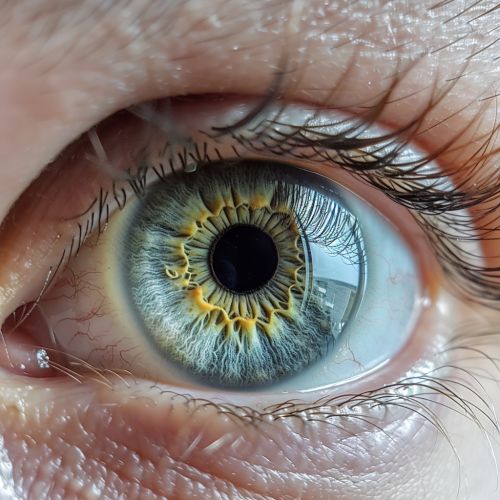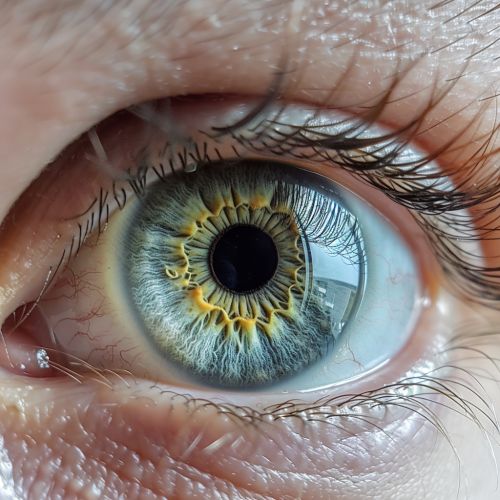Transduction (physiology)
Introduction
Transduction in physiology refers to the process by which a cell converts one kind of signal or stimulus into another. This is a fundamental mechanism in sensory systems, allowing organisms to detect and respond to their environment. Transduction mechanisms are crucial for various physiological processes, including vision, hearing, taste, smell, and touch. The process typically involves the transformation of a physical or chemical stimulus into an electrical signal that can be interpreted by the nervous system.
Mechanisms of Transduction
Transduction mechanisms vary depending on the type of stimulus and the sensory system involved. These mechanisms can be broadly categorized into mechanical, chemical, and electromagnetic transduction.
Mechanical Transduction
Mechanical transduction involves the conversion of mechanical stimuli, such as pressure or vibration, into electrical signals. This type of transduction is primarily observed in the auditory system and the somatosensory system.
Auditory System
In the auditory system, sound waves enter the ear and cause the tympanic membrane (eardrum) to vibrate. These vibrations are transmitted through the ossicles (small bones in the middle ear) to the cochlea in the inner ear. Inside the cochlea, the mechanical vibrations are converted into electrical signals by hair cells. The hair cells contain stereocilia that bend in response to the fluid waves within the cochlea, leading to the opening of ion channels and the generation of an electrical signal.
Somatosensory System
The somatosensory system detects mechanical stimuli such as touch, pressure, and vibration. Specialized receptors, known as mechanoreceptors, are responsible for this process. These receptors include Pacinian corpuscles, Meissner's corpuscles, and Merkel cells. When these receptors are deformed by mechanical stimuli, ion channels open, leading to the generation of an electrical signal.
Chemical Transduction
Chemical transduction involves the conversion of chemical stimuli into electrical signals. This mechanism is primarily observed in the olfactory system and the gustatory system.
Olfactory System
In the olfactory system, odorant molecules bind to specific receptors on the olfactory sensory neurons located in the olfactory epithelium. This binding activates a G-protein coupled receptor (GPCR) pathway, leading to the production of cyclic AMP (cAMP). The increase in cAMP levels opens ion channels, resulting in the generation of an electrical signal.
Gustatory System
The gustatory system detects chemical stimuli in the form of taste molecules. Taste receptors are located on the taste buds of the tongue. Different types of taste receptors are responsible for detecting sweet, sour, salty, bitter, and umami tastes. Binding of taste molecules to these receptors activates various signaling pathways, leading to the generation of an electrical signal.
Electromagnetic Transduction
Electromagnetic transduction involves the conversion of electromagnetic stimuli, such as light, into electrical signals. This mechanism is primarily observed in the visual system.
Visual System
In the visual system, light enters the eye and is focused onto the retina. The retina contains specialized photoreceptor cells known as rods and cones. These cells contain photopigments that undergo a conformational change when exposed to light. This change activates a GPCR pathway, leading to the closure of ion channels and the generation of an electrical signal.


Molecular Mechanisms
The molecular mechanisms underlying transduction processes are complex and involve various proteins, enzymes, and signaling pathways. Key components include ion channels, GPCRs, second messengers, and various kinases and phosphatases.
Ion Channels
Ion channels play a crucial role in transduction by allowing the flow of ions across the cell membrane. This flow generates electrical signals that can be transmitted to the nervous system. Different types of ion channels are involved in different sensory systems. For example, TRP channels are involved in temperature sensation, while HCN channels are involved in the auditory system.
G-Protein Coupled Receptors (GPCRs)
GPCRs are a large family of receptors that play a key role in chemical transduction. When a ligand binds to a GPCR, it activates an associated G-protein, which in turn activates or inhibits downstream signaling pathways. This can lead to the production of second messengers such as cAMP or inositol triphosphate (IP3), which further propagate the signal.
Second Messengers
Second messengers are small molecules that transmit signals from receptors to target molecules within the cell. Common second messengers include cAMP, IP3, and calcium ions (Ca2+). These molecules amplify the signal and activate various downstream effectors, leading to the generation of an electrical signal.
Kinases and Phosphatases
Kinases and phosphatases are enzymes that add or remove phosphate groups from proteins, respectively. These modifications can alter the activity of the proteins and play a crucial role in transduction pathways. For example, protein kinase A (PKA) is activated by cAMP and phosphorylates various target proteins, leading to changes in their activity.
Sensory Systems
Transduction processes are essential for the functioning of various sensory systems. Each sensory system has specialized receptors and pathways for detecting and processing specific types of stimuli.
Visual System
The visual system detects light and converts it into electrical signals that are processed by the brain to form images. The primary photoreceptors in the visual system are rods and cones. Rods are responsible for low-light vision, while cones are responsible for color vision and high-acuity vision.
Auditory System
The auditory system detects sound waves and converts them into electrical signals that are processed by the brain to perceive sound. The primary receptors in the auditory system are hair cells located in the cochlea. These cells convert mechanical vibrations into electrical signals.
Olfactory System
The olfactory system detects odorant molecules and converts them into electrical signals that are processed by the brain to perceive smell. The primary receptors in the olfactory system are olfactory sensory neurons located in the olfactory epithelium.
Gustatory System
The gustatory system detects taste molecules and converts them into electrical signals that are processed by the brain to perceive taste. The primary receptors in the gustatory system are taste receptor cells located on the taste buds of the tongue.
Somatosensory System
The somatosensory system detects mechanical, thermal, and nociceptive (pain) stimuli and converts them into electrical signals that are processed by the brain to perceive touch, temperature, and pain. The primary receptors in the somatosensory system include mechanoreceptors, thermoreceptors, and nociceptors.
Pathophysiology
Disruptions in transduction processes can lead to various sensory disorders. Understanding these disruptions can provide insights into the underlying mechanisms of these disorders and potential therapeutic targets.
Visual Disorders
Disruptions in visual transduction can lead to various visual disorders, such as retinitis pigmentosa, age-related macular degeneration, and color blindness. These disorders can result from mutations in genes encoding photoreceptors, photopigments, or other components of the visual transduction pathway.
Auditory Disorders
Disruptions in auditory transduction can lead to various auditory disorders, such as sensorineural hearing loss, tinnitus, and auditory neuropathy. These disorders can result from damage to hair cells, mutations in genes encoding ion channels, or disruptions in the signaling pathways involved in auditory transduction.
Olfactory Disorders
Disruptions in olfactory transduction can lead to various olfactory disorders, such as anosmia (loss of smell), hyposmia (reduced sense of smell), and parosmia (distorted sense of smell). These disorders can result from damage to the olfactory epithelium, mutations in genes encoding olfactory receptors, or disruptions in the signaling pathways involved in olfactory transduction.
Gustatory Disorders
Disruptions in gustatory transduction can lead to various gustatory disorders, such as ageusia (loss of taste), hypogeusia (reduced sense of taste), and dysgeusia (distorted sense of taste). These disorders can result from damage to taste buds, mutations in genes encoding taste receptors, or disruptions in the signaling pathways involved in gustatory transduction.
Somatosensory Disorders
Disruptions in somatosensory transduction can lead to various somatosensory disorders, such as neuropathy, allodynia (pain from non-painful stimuli), and hyperalgesia (increased sensitivity to pain). These disorders can result from damage to sensory neurons, mutations in genes encoding ion channels, or disruptions in the signaling pathways involved in somatosensory transduction.
Research and Future Directions
Research in the field of transduction is ongoing, with the aim of understanding the underlying mechanisms and developing new therapeutic approaches for sensory disorders. Advances in molecular biology, genetics, and neuroscience have provided new insights into the complex processes involved in transduction.
Molecular and Genetic Studies
Molecular and genetic studies have identified various genes and proteins involved in transduction processes. These studies have provided insights into the molecular mechanisms underlying sensory disorders and potential therapeutic targets. For example, gene therapy approaches are being developed to restore function in individuals with genetic mutations affecting transduction pathways.
Neuroprosthetics
Neuroprosthetics is an emerging field that aims to develop devices that can replace or restore sensory functions. For example, cochlear implants are used to restore hearing in individuals with sensorineural hearing loss by directly stimulating the auditory nerve. Similarly, retinal implants are being developed to restore vision in individuals with retinal degeneration.
Pharmacological Approaches
Pharmacological approaches are being explored to modulate transduction pathways and treat sensory disorders. For example, drugs that target ion channels or GPCRs involved in transduction pathways are being developed to treat conditions such as chronic pain, tinnitus, and anosmia.
Conclusion
Transduction is a fundamental process in physiology that allows organisms to detect and respond to their environment. Understanding the mechanisms of transduction is crucial for understanding sensory systems and developing new therapeutic approaches for sensory disorders. Ongoing research in this field continues to provide new insights and potential treatments for various sensory conditions.
